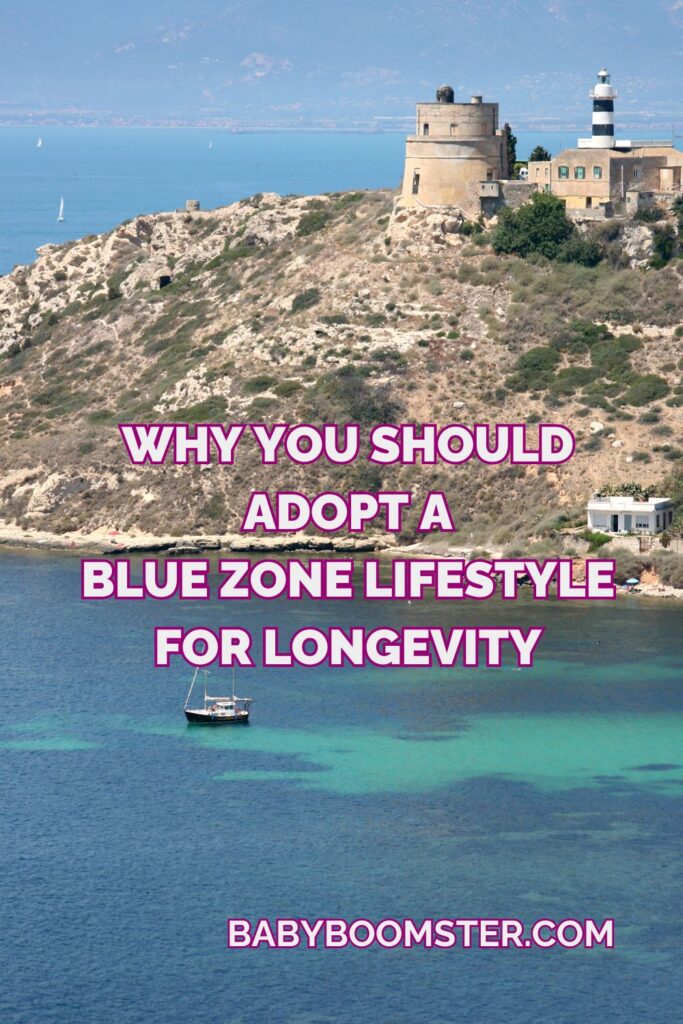I wrote a post about Tips to Live to a Ripe Old Age but then watched a five-part series called “Live to 100: Secrets of the Blue Zones” with Dan Buettner on Netflix. I’ve been fascinated by the Blue Zones and his writings ever since I started this blog in 2012. If you haven’t seen the series yet, I highly recommend it.
I’ve written many posts on the topic of longevity as well as diet and nutrition for active aging, but I wanted to highlight some of the points Buettner made in the series.
You will see centenarians doing things you can’t even imagine like a 102-year-old man in Costa Rica riding a horse and herding cattle. Or Japanese people who are 90 + in Okinawa doing low squats and getting up and down off the floor.
The 5 Blue Zones in the world
A blue zone is an area where there is a large population of people who are super-agers, meaning they have lived to age 100 or more. Buettner visited 5 of these areas which include the Island of Okinawa in Japan, Ikaria in Greece, Cagliari on the island of Sardinia, Loma Linda near San Bernadino, California, and Nicoya in Costa Rica.
Similarities that centenarians share
Although each culture and its cuisine are different, centenarians have similar habits that have allowed them to live to extreme old age with very little illness, disability, or cognitive decline.
All of them stay active in some way. In Ikaria and Sardinia, for example, the aged climb steep hills, garden, herd goats, dance, and build muscles making pasta dough.
The elderly in Okinawa also walk and have excellent flexibility in their bodies. They also garden, practice Tai Chi, and do other natural exercises.
Most of the aged in the Blue Zones have never seen the inside of a gym.
Northern Costa Ricans keep working until they pass on. They are mostly poor but are often outdoors walking, cutting wood, and performing daily tasks.
Loma Linda, in California, is not a place where you would expect centenarians to thrive. The area is a suburb near San Bernardino and is notorious for its smog. Its Seventh-Day Adventist community is spiritually connected and promotes good nutrition and physical activity.
Most Adventists are either vegetarian or vegan and eat a plant-based diet. The other 4 Blue Zones consume a diet that is rich in whole grains, fruits, vegetables, and legumes but sometimes eat small portions of animal protein and fish.
In Okinawa, a typical meal may contain Japanese Red Sweet Potatoes, bitter melon (Goya Chanpuru), seaweed, and fermented tofu. They drink green tea daily.
Ikarians live on an island with no natural ports. For many years they had no access to grocery stores and had to make do on their own. They milled their own wheat, barley, and chickpeas and learned about the medicinal aspects of plants. Many of them drink a combination of herbs in a tea that includes dandelion, sage, rosemary, and other plants.
Bees on the island have been harnessed and the Ikarian consume their raw honey in abundance. Honey has outstanding medicinal benefits and is used as a sweetener instead of sugar.
Sardinians are famous for consuming bowls of homemade minestrone soup made from seasonal vegetables as well as plenty of pasta and sourdough breads. They live in remote villages with steep stairs and their homes are 3-4 stories.
In Nicoya Costa Rica, beans, squash, corn, and rice are diet staples. Many Nicoyans cannot afford meat and only eat it on special occasions.
None of the people in the Blue Zones cut out carbs. Pasta, noodles, rice, corn, and other grains are eaten in abundance.
Seventh Day Adventists do not drink alcohol but in the other 4 Blue Zones wine, beer, or sake (Okinawa) is enjoyed on a regular basis in moderation.
Other similarities shared by Superagers
A sense of purpose is key to centenarians everywhere. When you give up on life it will be cut short. Retirement is not an option for most Blue Zoners. They always stay busy and have a sense of purpose. Most are spiritual in some way, stay connected with family and friends, and nurture long-lasting love relationships.
Okinawans practice Ikigai which is a concept that promotes a sense of balance and harmony in life. Costa Rica has a similar philosophy called Plan de Vida, which means “soul’s purpose” or “why do I get up in the morning?”
Another similarity with centenarians is their easygoing nature. Life will always have obstacles, but they do not dwell on them, work on solving problems, and do not hold grudges.
In all areas designated Blue Zones the elderly are well taken care of and live with friends and relatives rather than nursing homes. They live years longer when they age in place.
Buettner is on a mission to turn ordinary cities in the U.S. and other locations into Blue Zones through his Blue Zones Project.
Sadly, some of the Blue Zones have fewer centenarians because these areas are being overrun with fast food restaurants, environmental concerns, and modern technology.
Given these habits, it may be well worth adopting them. If you think it’s too late to start, the series talked about a 60-ish-year-old man who was diagnosed with terminal cancer. He left his home and moved to Ikaria where he lived to be 102.
Do you practice lifestyle habits like the centenarians in the Blue Zones? Please leave a comment and tell us about it.




Leave a comment and tell us what you think